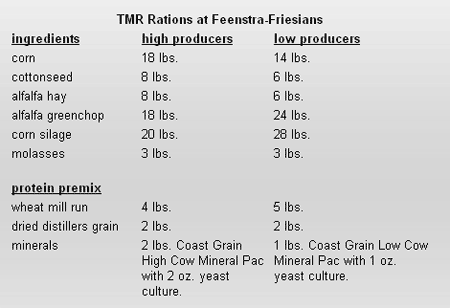Managing Facilities and Feed to Help Minimize Heat Stress
Published: August 30, 2007
By: Deb DeGraff Edwards - (Courtesy of Diamond V Mills Inc.)
The effects of heat stress, however, tend to be seen long after the high temperatures cool. According to dairy nutrition experts, production losses can continue for the remainder of the lactation, and can mean a loss of 5, 10, or even 20 pounds of milk production per day for each day that is left in the lactation.
Good management of facilities and feed rations can help maintain optimal herd performance. They helped the 1,200-head Feenstra-Friesians dairy near Chandler, Arizona. Owned and managed by David Feenstra, the dairy has a rolling herd average of 24,700 lbs. FCM on 3X milking, with about 60% of the cows receiving supplemental BST.
"Dave’s herd was one of the few that were able to recover quickly and get back to high milk production last October," says Naji Nassereddine, a nutritionist from Coast Grain Company in Phoenix who works with Feenstra. "His cows started hitting 80 lbs. of milk around the end of the month, which is really good here in Arizona."
In the heat of the summer, the herd averaged 65 lbs. per head per day.
"We battle heat stress every summer," says Feenstra. "It starts in June and peaks during August and September."
As temperature and humidity levels rise, cows become uncomfortable and their internal temperature becomes elevated. Trying to cool themselves, the cows seek out shady spots and begin panting. While the panting helps relieve some of the animals’ stress, it also prevents them from eating or regurgitating or chewing their cud, thereby reducing rumen function.
The first line of defense that Feenstra uses against heat stress helps cool the cows: fans, misters, manger shades with misters, and an ever-ready supply of fresh water. In addition, the cows are fed during the cooler parts of the day to encourage consumption.
His second line of defense consists of a properly balanced, highly palatable feed ration. Last year for the first time, the ration included yeast culture to enhance palatability and maintain high levels of digestibility. Feenstra was feeding a total mixed ration prepared on-farm.
"One of the tools I’ve found that helps cows [through heat stress] is the addition of a yeast culture to the ration because it helps maintain dry matter intake," explains Nassereddine, who agrees that heat stress presents two main problems. "One is keeping the cow’s body temperature normal and the other is helping the cow maximize fiber digestion.
"Keeping dry matter intake adequate is a major problem that dairymen really worry about; they wonder how they’re going to get their cows through the summer and back on track for fall production," he continues. Yeast culture enhances the palatability of rations and helps maintain optimal fiber digestion.
"The main reason I went with adding the yeast culture after Naji recommended it was to help the cows maintain body condition during hot summer months," explains Feenstra. "If cows are in good body condition they transition better going in to the fall and milk better."
Feenstra’s higher producing cows receive two ounces of yeast culture per day in their TMR, while lower producers receive one ounce.
Feenstra switched to the TMRs for cost savings and flexibility.
His rations typically contain corn, alfalfa greenchop, cottonseed, molasses, alfalfa hay, corn silage, wheat millrun, dried distillers grain, and one of two mineral supplements from Coast Grain Co. The high cow ration contains 18.45% crude protein, 79.35% total digestible nutrients, 20% acid detergent fiber, and 31.82% neutral detergent fiber. The low cow ration contains 17.74% crude protein, 77.0% TDN, 20.77% ADF, and 33.73% NDF.
"Using a TMR is economical and allows us the flexibility to spike the ration for the high producing cows a little bit without having to spend extra money on the lower producing cows," explains Nassereddine. "In the protein premix that we supply for Feenstra’s herd, we have the luxury of putting in extra additives like Megalac, and a little extra buffer and fat. These seemed to really help the cows last summer."
Extra additives, however, must prove their cost effectiveness to this dairy producer. "I’m not one to jump on every bandwagon and try every new product that comes along," says Feenstra. "You question the cost-effectiveness of everything you do. Your feed costs have to be in order if you want to make a profit. It costs me about four cents per head per day to include the yeast culture in my herd’s ration, and it definitely pays off.
"When Naji recommended adding it, I’d heard about it but really hadn’t thought to use it before. The results we saw last summer were great, and we’ve continued to keep yeast culture in the ration year-round. It would take some serious consideration before I’d cut it out."
The use of yeast culture has increased dramatically in recent years. From the early 1980s to the early 1990s the use of yeast-type products among top DHIA herds increased from about 15% to about 55%, according to dairy nutrition experts. The type of yeast culture Coast Grain Co. feeds has been manufactured by Diamond V Mills for more than 50 years. It is an all-natural ingredient that can be top-dressed, mixed in grain rations, TMRs, liquid feeds or incorporated in minerals and premixes. It is a true yeast culture, not yeast mixed with carrier or a yeast by-product.
While heat stress will likely remain a perennial concern, dairymen can minimize the concern by better managing their herd for optimal performance.

Deb DeGraff Edwards is a Missouri-based freelance writer who specializes in dairy and agricultural topics.
Related topics:
Recommend
Comment
Share

Would you like to discuss another topic? Create a new post to engage with experts in the community.
Featured users in Dairy Cattle

José Manuel Oropeza Meza
MSD - Merck Animal Health
Gerente Nacional Cuentas Clave en MSD Salud Animal
United States
United States






